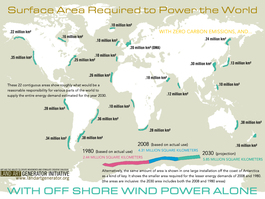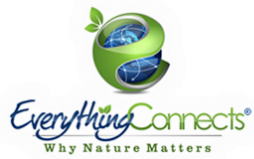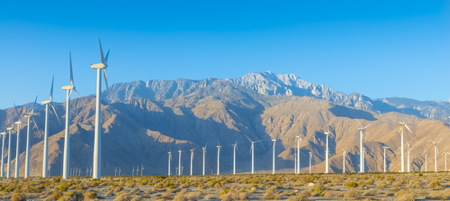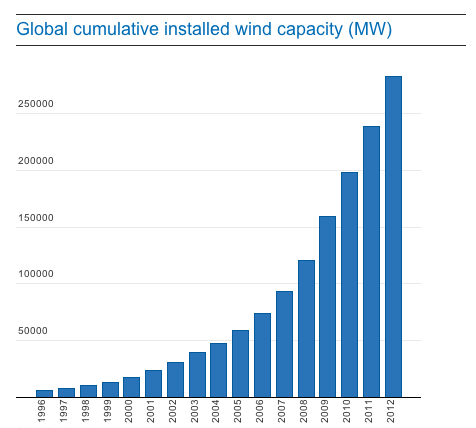Wind Power
|
Navigation
Wind is expected to supply 1/10th of the world's power by 2020, saving nearly 1.7 billion tons of CO2 emissions. By 2030, wind power could provide a fifth of global electricity. Learn more.
"You know what happens when windmills collapse into the sea? A splash." ~Bill Maher
|
 Click to enlarge. Credit: Land Art Generator Initiative
Wind power, which is the conversion of wind energy into electricity through the use of wind turbines, is a viable alternative to fossil fuels that is pollution-free, affordable, efficient, plentiful, renewable, clean, widely distributed, produces no greenhouse emissions during operation, uses little land, is an inexhaustible source of electricity and can be harvested nearly everywhere, whether in valleys, on mountains, in your backyard or in the sea. Wind power is one of the most cost-effective sources of electricity available, capable of generating power at prices competitive with new natural gas plants and cheaper than new coal and nuclear plants, and is already cheaper than coal and natural gas in Australia - with solar is right behind. However, if you take into account the very real health and environmental damage from fossil fuels, wind and solar power is the least expensive energy sources worldwide. Drawbacks to wind turbines is that their construction and operation can create an undesirable landscape with their strikingly large visual appearances and pose a danger to birds and bats in the area with their turning rotors. However, the benefits of wind energy far outweigh the plethora of environmental, social, economic and public health costs associated with the use of fossil fuels, such as coal, oil and natural gas, and there are major innovations and advances being made within the wind industry to counteract these drawbacks and further advance and even double the efficiency of harnessing the wind. The wind industry has been growing rapidly in recent years with an increase of 20% global wind capacity in 2012, largely driven by China and the US, and with new designs transforming offshore wind (see also). According to the Natural Resources Defense Council, in 2010 alone, 2,900 turbines went up across the United States, and today, American wind generates enough electricity to power more than 10 million homes, creates steady income for investors and landowners, and helps support over 100,000 manufacturing and ongoing operations and maintenance jobs. Learn more.
|
|
Benefits Of Wind Power
|
Union of Concerned Scientists: Tapping into Wind Power
Your browser does not support viewing this document. Click here to download the document.
"Already, wind energy can compete with coal powered energy in terms of cost at around 4 cents per kilowatt hour. However, the federal government's National Renewable Energy Laboratory projects that the price of wind energy will fall even further over the next decade, making it the most economically competitive renewable energy technology. As a growing power source, wind energy can become a major force for economic development. Wind development can save consumers money and bring construction jobs, leasing royalties, and increased tax revenues to local communities. If the United States were to reach the DOEs 20 percent wind energy supply scenario roughly 800,000 jobs would be created, annual property tax revenues would increase to $1.5 billion, and annual payments to rural landowners would increase to $600 million by 2030." ~Sierra Club
The World Wind Energy Association: 2012 Half-Year Report
Your browser does not support viewing this document. Click here to download the document.
|
|
"The wind energy industry is booming. Globally, generation more than quadrupled between 2000 and 2006. At the end of last year, global capacity was more than 70,000 megawatts. In the energy-hungry United States, a single megawatt is enough electricity to power about 250 homes. Germany has the most installed wind energy capacity, followed by Spain, the United States, India, and Denmark. Development is also fast growing in France and China.Industry experts predict that if this pace of growth continues, by 2050 the answer to one third of the world's electricity needs will be found blowing in the wind." ~National Geographic: Wind Power
Your browser does not support viewing this document. Click here to download the document.
|
"The world needs to transition from its current unsustainable energy paradigm to a future powered by entirely renewable energy supply. Only by making such a transition will we be able to avoid the very worst impacts of climate change. WWF’s ground-breaking energy study - The Energy Report - shows that this future is within our reach, and provides a vital insight into how it can be achieved. A growing number of leaders - from within the policy arena, business, media, and civil society, are questioning the views of conventional experts on the world’s energy future, and their “business-as-usual” scenarios, embarking on a serious search for realistic alternatives. Their reasoning is obvious: minimizing climate change impacts will require substantial cuts in global emissions - as quickly as possible. The world has reached peak conventional oil and gas, meaning oil and gas companies are digging deeper and deeper into unconventional sources, with disastrous environmental and social consequences. Coal is still relatively readily available, but catastrophic in terms of climate changing emissions. The world can no longer afford to hang on to its old energy paradigm, and its dangerous dependence on fossil fuels." ~WWF, The Energy Report: 100% Renewable Energy by 2050 Greenpeace: The Energy [R]evolution - A Sustainable Energy World Outlook
Your browser does not support viewing this document. Click here to download the document.
"A number of studies have suggested that the damage done to bird populations by wind energy is small, though real. Nor is the fossil fuel industry safe from similar critique; one study suggests that half a million to a million birds die each year at oil producing facilities. Even Trump’s beloved skyscrapers are likely responsible for more bird deaths than wind farms." ~Philip Bump, Grist |
"Wind energy provides clean, renewable power that doesn’t pollute our air, harm our health or keep us tied to the fuels of last century. But as two new NRDC studies (here and here) show that’s just the beginning of the benefits of wind energy. The wind energy industry is creating jobs for American workers and breathing fresh air into economically struggling communities by providing new sources of revenue for landowners, cities, and towns, the two reports show. Wind energy is also giving American companies the opportunity to participate in a booming global industry." ~Peter Lehner, NRDC
|
|
|
Last Revised: 11/20/13
Commenting Rules |



